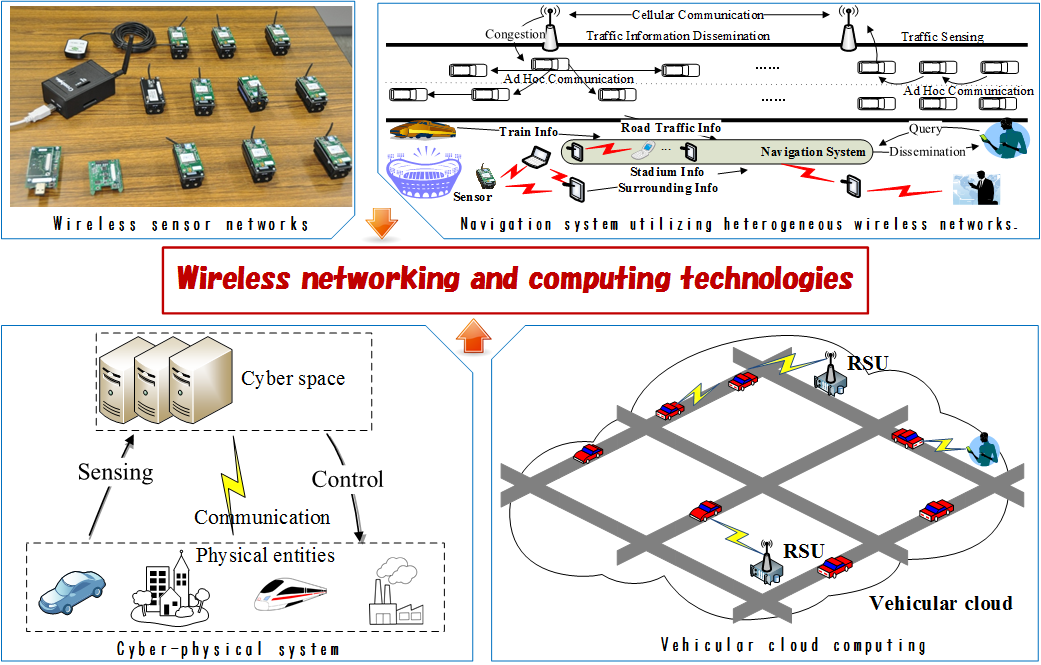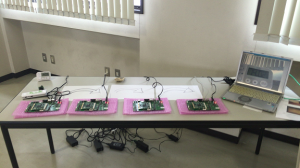Celimuge Wu Laboratory (Intelligent Networks and Systems Lab)
Welcome to Intelligent Networks and Systems Lab
Our research interests include all aspects of wireless networking and computing technologies. Recently, we have been focusing on vehicular networks, sensor networks, cloud computing, IoT (Internet of things), big data, web service and ubiquitous systems. More specifically, our current on-going projects are as follows.
1. Video streaming with autonomous distributed IoT technology
With the increase of IoT devices, it becomes difficult to provide all the communications using traditional infrastructure-based technologies such as cellular systems. In this study, we propose to use autonomous distributed communications between IoT devices, and develop a video streaming system based on this approach.
2. V2R, V2V, V2P cooperative communication and control protocol for CPS
A cyber-physical system is a collaboration of computational elements and physical entities utilizing communication, sensing and control technologies. In recent years, cyber-physical system (CPS) has been attracting great interests due to its importance for enabling a smart world. The vehicular network is considered to be one of the most important parts of CPS (car-to-car communication is recognized as one of the 10 breakthrough technologies in 2015 by MIT Technology Review). In this research, we focus on cooperative vehicular communication protocols for CPS. By utilizing CPS sensing technologies, vehicle-to-roadside (V2R), vehicle-to-vehicle (V2V), and vehicle-to-pedestrian (V2P) communications, this research is trying to provide solutions for collision avoidance systems, intelligent transport systems and post-disaster communications.
For a large event like Olympic game, it is particularly important to design an efficient navigation system to guide visitors to the stadium and provide event-related information in the stadium. Since existing navigation systems like VICS (Vehicle Information and Communication System) in Japan are dependent on pre-installed infrastructure and centralized control, they cannot attain expected real-time and accurate information dissemination. It is very likely that all people will be guided to the same route (resulting in congestion on that route) because the existing systems do not take into account the load balancing and user-behavior based adjustment. In order to solve this problem, we propose a distributed cooperative framework for navigation system and design the corresponding communication protocols for the framework. This research focuses on the following three parts: 1) using vehicle-to-vehicle, vehicle-to-roadside, vehicle-to-pedestrian, and machine-to-machine cooperative communications to maintain user route search information in a distributed (without centralized control) network in order to provide the best route for each user and balance the traffic load by predicting the user behavior 2) using crowdsourcing technology to gather surrounding information with various types of sensing devices 3) designing a system which can provide a real-time navigation service integrating train information, road traffic information and inside-stadium information where a user only needs to install a smart phone application.
4. Big data collection and processing for vehicular networks
Vehicles are always equipped with various sensors, and the corresponding sensor data can be used for the transportation planning, design of intelligent transport systems, improvement of vehicle parts, surveillance systems, and scheduling system for electric vehicles in smart grid. Therefore, the problem of how to efficiently collect, process and utilize these big data becomes particularly important. In this research, we focus on two aspects specifically 1) efficient collection of vehicle data, and 2) processing of big data utilizing computing resources of vehicles.
5. IoT system utilizing distributed communications between sensor devices
By using IoT, sensor networks and multi-hop networking technologies, we can collect a patient’s information to the data servers efficiently, which can facilitate the diagnosis and management process in a hospital. In this research, we propose an IoT solution, especially targeting medical applications, based on ad-hoc communications between sensor devices.
6. Cloud computing for 5G heterogeneous networks
5G (5th generation wireless systems) has to support more than 10Gbps access speed, 50 billion connected devices, and 5 times reduced end-to-end latency. In order to provide this extremely high quality of services, it is important to utilize cloud computing technologies for heterogeneous networks. This research focuses on the joint optimization of communication resources and computing resources in cloud computing framework for 5G heterogeneous networks. The intelligent resource management based on SDN (Software-Defined Network) is addressed as well.







